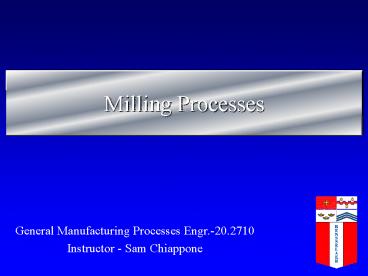Milling Processes - PowerPoint PPT Presentation
1 / 23
Title:
Milling Processes
Description:
Milling Processes General Manufacturing Processes Engr.-20.2710 Instructor - Sam Chiappone Milling Processes Milling is one of the basic machining processes. – PowerPoint PPT presentation
Number of Views:247
Avg rating:3.0/5.0
Title: Milling Processes
1
Milling Processes
- General Manufacturing Processes Engr.-20.2710
- Instructor - Sam Chiappone
2
Milling Processes
- Milling is one of the basic machining processes.
Milling is a very versatile process capable of
producing simple two dimensional flat shapes to
complex three dimensional interlaced surface
configurations.
3
The Process
- The milling process
- Typically uses a multi-tooth cutter
- Work is fed into the rotating cutter
- Capable of high MRR
- Well suited for mass production applications
- Cutting tools for this process are called milling
cutters
4
Classifications
- Milling operations are classified into two major
categories - Peripheral (side)
- Generally in a plane parallel to the axis of the
cutter - Cross section of the milled surface corresponds
to the contour of the cutter - Face
- Generally at right angles to the axis of rotation
of the cutter - Milled surface is flat and has no relationship to
the contour of the cutter - Combined cutting action of the side and face of
the milling cutter
5
Related Operations
- Side milling - machining a plane surface
perpendicular to the milling machine arbor with
an arbor mounted tool. This tool is called a
side mill. - Straddle milling - milling two parallel surfaces
using two cutters spaced apart on an arbor. - Gang milling - milling multiple surface
simultaneously using multiple cutters mounted on
an arbor. - Thread milling - milling treads using the
capability of a three axis contouring CNC
machine.
6
Operating Parameters
- Rpm
- CS converted into Rpm based on cutter diameter
- Feed rate
- Feed per tooth
- Table feed rate
7
Operating Parameters
- Feed direction -- Conventional vs. Climb
- Conventional milling
- Most common method of feed
- Feed work against the rotation of the cutter
8
Operating Parameters
- Feed direction - Conventional vs. Climb
- Climb milling
- Load of the cutter tends to pull the work into
the cutter - This results in a small feed force and about 20
less Hp than conventional milling - Downward motion increases the load on the table
ways - This method can pull the work into the cutter
and scrap the work and/or damage the fixture and
tool. - Machine must be very ridged to safely utilize
climb milling(CNC machines) - USE CAUTION!
9
Operating Parameters
- Conventional vs. Climb Milling
10
Operating Parameters
- Depth of cut
- Horsepower
11
Milling machines
- Two Major Classifications - Knee Column and Bed
- Knee Column (Bridgeport type)
- Basic job shop type mill
- Column mounted to the base which is the major
support frame. - Construction provides controlled motion of the
worktable in three mutual perpendicular
directions. - Knee moves vertically on the ways in the front of
the machine - Table moves longitudinally on the ways on the
saddle - Saddle moves transversely on the ways on the knee
- Quill moves parallel in Z axis or, if head is
rotated, X axis - Versatile general purpose machine
12
Milling Machines
- Bed
- Used extensively in production milling operations
- Rigid construction capable of heavy cuts
- Table is mounted directly to the bed
- Spindle head moves vertically to set depth of cut
- Head locks into position for cut
- Base of machine functions as a coolant reservoir
13
Milling Machines
14
Milling Machines
15
Milling Machines
16
Variation of Machines
- Variations include
- Horizontal
- Vertical
- Profilers and duplicators
- CNC
- Planner
17
Variation of Machines
- CNC
- Horizontal, Vertical,and Planner (up to 5 axis)
18
Process Accuracy
- Accuracy of milling machines
- Factors to consider
- Fixture
- Rigidity of machine tool
- Accuracy of the spindle
- Cutter condition
- Coolant
- Type
- Delivery method
- Material condition
19
Process Accuracy
- /- .0005 - Optimum situation
- /- .001-.002 - Typical
- /- .001 - Flatness
20
Milling Cutter Classifications
- Arbor
- Shank
- Face
21
Milling Cutters
22
Workholding Devices
- Vise
- Chucks
- Rotating tables
- Angle plates
- Special fixtures
- Universal dividing head
- Modular fixturing systems
- Clamp work to table
23
Workholding Devices































